Carmagnola
RSP 10980
General Information
- Sample Name
- Carm_24_1_CSU
- Accession Date
- July 16, 2017
- Reported Plant Sex
- Female
- Report Type
- StrainSEEK v2 3.2Mb
- DNA Extracted From
- Unknown
The strain rarity visualization shows how distant the strain is from the other cultivars in the Kannapedia database. The y-axis represents genetic distance, getting farther as you go up. The width of the visualization at any position along the y-axis shows how many strains there are in the database at that genetic distance. So, a common strain will have a more bottom-heavy shape, while uncommon and rare cultivars will have a visualization that is generally shifted towards the top.
Chemical Information
Cannabinoid and terpenoid information provided by the grower.
Cannabinoids
No information provided.
Terpenoids
No information provided.
Genetic Information
- Plant Type
- Type III
File Downloads
The bell curve in the heterozygosity visualization shows the distribution of heterozygosity levels for cannabis cultivars in the Kannapedia database. The green line shows where this particular strain fits within the distribution. Heterozygosity is associated with heterosis (aka hybrid vigor) but also leads to the production of more variable offspring. When plants have two genetically different parents, heterozygosity levels will be higher than if it has been inbred or backcrossed repeatedly.
The ratio of reads mapped to Y-contigs to reads mapped to the whole Cannabis genome (Y-ratios) has been demonstrated to be strongly correlated with plant sex typing. This plot shows the distribution of Y-ratios for all samples in our database which were sequenced with the same method (panel or WGS) as this sample and where this sample falls in the distribution.
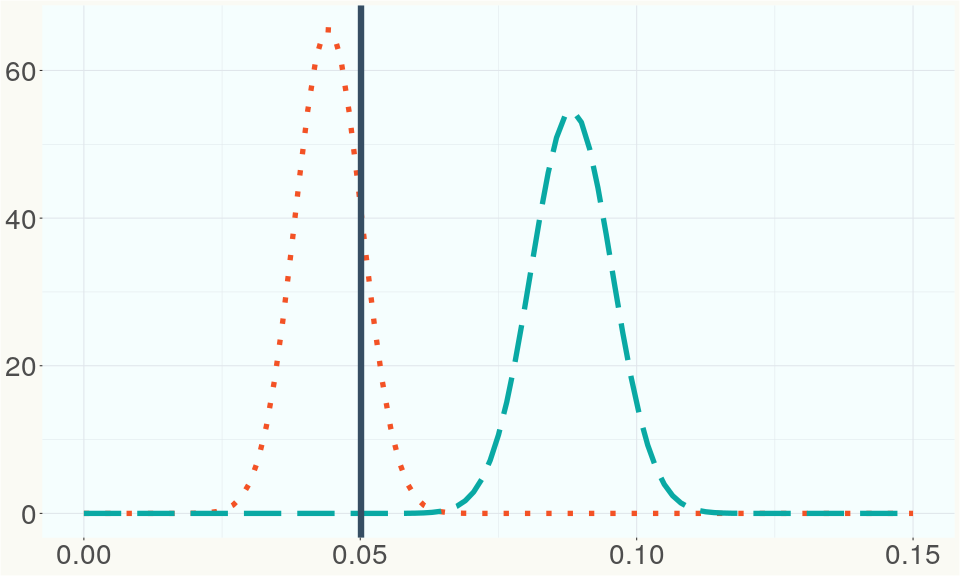
This chart represents the Illumina sequence coverage over the Bt/Bd allele. These are the three regions in the cannabis genome that impact THCA, CBDA, CBGA production. Coverage over the Active CBDAS gene is highly correlated with Type II and Type III plants as described by Etienne de Meijer. Coverage over the THCA gene is highly correlated with Type I and Type II plants but is anti-correlated with Type III plants. Type I plants require coverage over the inactive CBDA loci and no coverage over the Active CBDA gene. Lack of coverage over the Active CBDA and Active THCA allele are presumed to be Type IV plants (CBGA dominant). While deletions of entire THCAS and CBDAS genes are the most common Bt:Bd alleles observed, it is possible to have plants with these genes where functional expression of the enzyme is disrupted by deactivating point mutations (Kojoma et al. 2006).
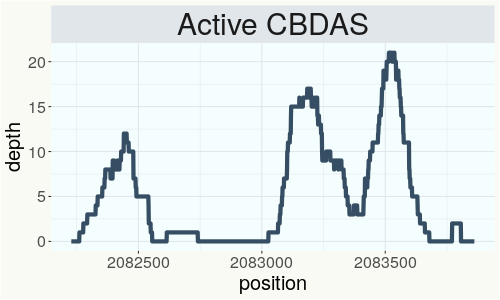
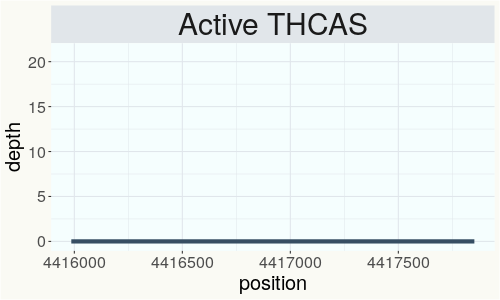
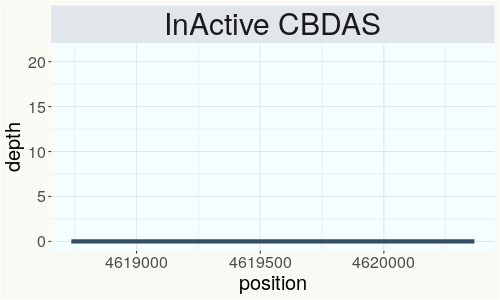
This chart represents the Illumina sequence coverage over the CBCA synthase gene.
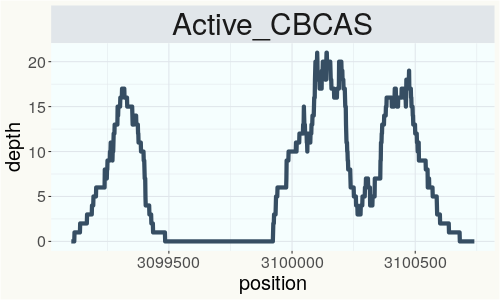
Variants (THCAS, CBDAS, and CBCAS)
No variants to report
Variants (Select Genes of Interest)
| PKSG-2b | c.1117A>G | p.Ile373Val | missense variant | moderate | contig700 | 1950521 | T/C | |
| PKSG-4b | c.523C>T | p.His175Tyr | missense variant | moderate | contig700 | 2721150 | G/A | |
| PKSG-4b | c.489delT | p.Phe163fs | frameshift variant | high | contig700 | 2721183 | CA/C | |
| aPT4 | c.757G>T | p.Val253Leu | missense variant | moderate | contig121 | 2831364 | G/T |
|
| aPT1 | c.574A>T | p.Met192Leu | missense variant | moderate | contig121 | 2840182 | A/T |
|
| aPT1 | c.629C>T | p.Thr210Ile | missense variant | moderate | contig121 | 2840237 | C/T | |
| aPT1 | c.727G>T | p.Glu243* | stop gained | high | contig121 | 2841362 | G/T |
Nearest genetic relatives (All Samples)
- 0.002 Carmagnola (RSP11037)
- 0.002 Carmagnola (RSP10982)
- 0.003 Carmagnola (RSP10977)
- 0.003 Carmagnola (RSP11039)
- 0.139 Carmagnola (RSP10655)
- 0.145 Carmagnola (RSP10976)
- 0.146 Carmagnola (RSP10978)
- 0.152 Carmagnola (RSP10979)
- 0.160 Carmagnola (RSP11202)
- 0.183 CS (RSP11208)
- 0.205 Santhica27 (RSP10056)
- 0.212 VIR 37 - Novgorod-Seversky - cv (SRR14708234)
- 0.219 Carmagnola USO 31 (RSP11204)
- 0.219 VIR 201 (SRR14708232)
- 0.221 Santhica27 (RSP11047)
- 0.224 Santhica27 (RSP11046)
- 0.225 Tisza (RSP11044)
- 0.226 Santhica 27 (RSP10665)
- 0.226 Kompolti (SRR14708277)
- 0.227 Ivory (RSP10668)
Most genetically distant strains (All Samples)
- 0.447 Cherry Blossom (RSP11312)
- 0.447 Cherry Blossom (RSP11298)
- 0.446 Cherry Blossom (RSP11328)
- 0.437 Cherry Blossom (RSP11323)
- 0.437 Chem 91 (RSP11185)
- 0.430 Cherry Blossom (RSP11309)
- 0.428 Cherry Blossom (RSP11300)
- 0.422 New York City Deisel (RSP11225)
- 0.420 RKM-2018-002 (RSP11093)
- 0.419 Super Sour Diesel (RSP11191)
- 0.418 Cherry Blossom (RSP11311)
- 0.418 Cherry Blossom (RSP11318)
- 0.418 Queen Dream CBG (RSP11293)
- 0.417 JL X NSPM1 30 (RSP11476)
- 0.417 Cherry Blossom (RSP11301)
- 0.416 Northern Skunk (RSP11456)
- 0.416 JL Tent 4 (RSP11491)
- 0.415 Cherry Blossom CBG (RSP11303)
- 0.415 Cherry Blossom (RSP11334)
- 0.414 JL Cross 14 (RSP11515)
Nearest genetic relative in Phylos dataset
- Overlapping SNPs:
- 49
- Concordance:
- 34
Nearest genetic relative in Lynch dataset
- Overlapping SNPs:
- 4
- Concordance:
- 4
Blockchain Registration Information
- Transaction ID
-
cc1c3534b46af787
f9f34db17ac54601 aa067eaca99be128 67060c929adb34ca - Stamping Certificate
- Download PDF (864.2 KB)
- SHASUM Hash
-
2b0cb42b290f310c468e3883d331fe53 4a7da378dc269a20 738a5013f8ecb983